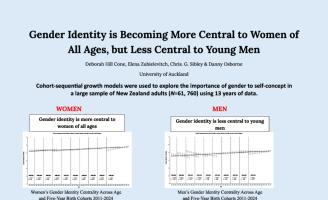性别认同对所有年龄段的女性来说都变得越来越重要,但对年轻男性来说却不那么重要
IF 2.2
Current research in ecological and social psychology
Pub Date : 2025-01-01
DOI:10.1016/j.cresp.2025.100242
引用次数: 0
摘要
尽管传统的性别角色在许多西方社会受到挑战,但很少有研究考察性别认同中心是如何随着时间和不同世代而变化的。在这里,我们使用来自新西兰全国随机成人样本(N = 61,760)的纵向面板数据来评估2011年至2024年期间男性和女性性别认同中心性的变化,这些数据来自10个不同的出生队列,年龄在18岁至73岁之间。队列序列增长模型揭示了男性和女性相反的增长轨迹。性别认同中心性在除了两个出生队列之外的所有女性出生队列中都有所增加,而男性的性别认同中心性在四个最年轻的出生队列中有所下降,在三个最年长的出生队列中有两个有所增加。我们的研究结果表明,女性受年龄和经期影响,男性受群体影响。虽然还需要进一步的测试,但我们的结果表明,性别在女性的一生中变得越来越重要,而年轻男性开始越来越多地与自己的性别保持距离。本文章由计算机程序翻译,如有差异,请以英文原文为准。

Gender identity is becoming more central to women of all ages, but less central to young men
Although traditional gender roles are being challenged in many Western societies, few studies have examined how gender identity centrality has changed over time and across different generations. Here, we use longitudinal panel data from a nationwide random sample of adults in New Zealand (N = 61,760) to assess change in men’s and women’s gender identity centrality from 2011 to 2024 across 10 distinct birth cohorts spanning the ages of 18 to 73. Cohort-sequential growth models revealed countervailing growth trajectories for men and women. Whereas gender identity centrality increased among all but two of the birth cohorts for women, men’s gender identity centrality both decreased (among the four youngest birth cohorts) and increased (in two of the three oldest cohorts). Our findings imply aging and period effects for women, and cohort effects for men. Although further testing is required, our results suggest that gender is becoming more central to women’s identity across the lifespan and that young men are starting to increasingly distance themselves from their gender.
求助全文
通过发布文献求助,成功后即可免费获取论文全文。
去求助
来源期刊

Current research in ecological and social psychology
Social Psychology
CiteScore
1.70
自引率
0.00%
发文量
0
审稿时长
140 days
 求助内容:
求助内容: 应助结果提醒方式:
应助结果提醒方式:


